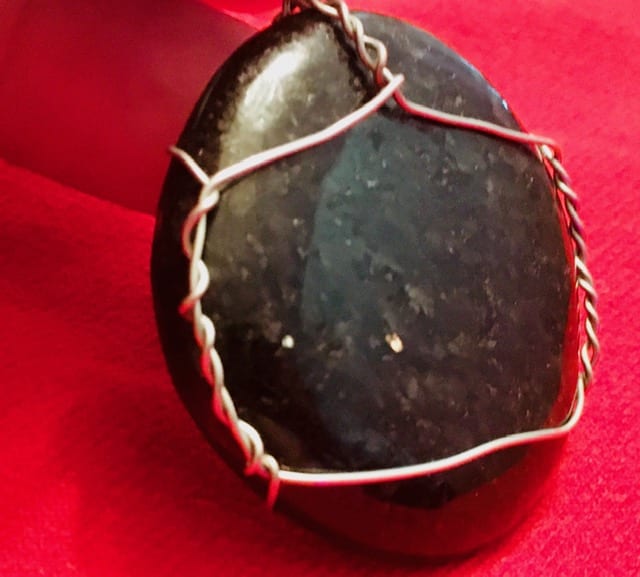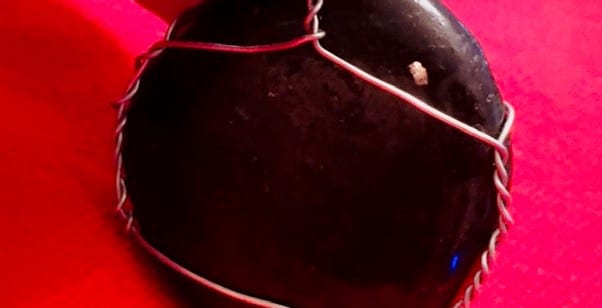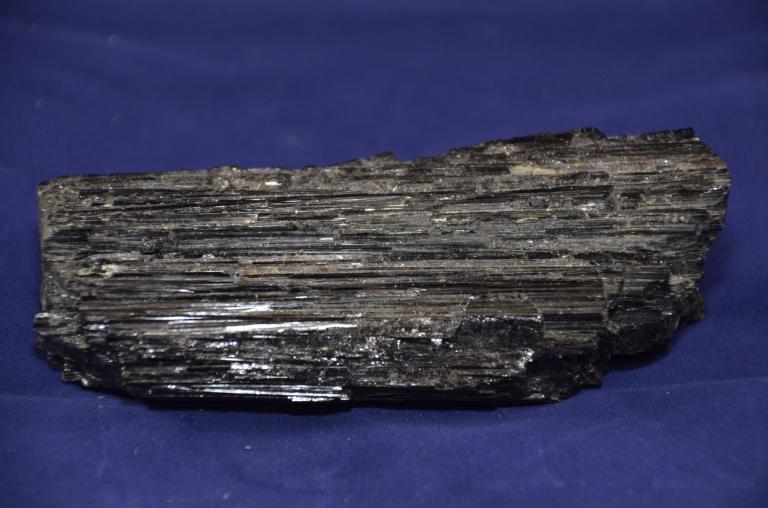Recently, I was drawn to start working with nuummite (variously spelled nuumite, nuumit, and nuummit), an iridescent metamorphic stone discovered near Nuuk, Greenland in 1982, by geologist Peter W. Uitterdijk Appel. Samples of this rock, collected by L. K. Giesecke in 1810, are also stored in the Mineralogical Museum in Copenhagen Denmark.

Metamorphic stones are formed of materials that have undergone intense heat and pressure deep under the Earth’s crust. Metamorphic rocks include marble, anthracite, quartzite, slate and others. In the case of nuummite, two minerals, gedrite (a magnesium) and anthophyllite were fused together with other minerals such as pyrite, more commonly known as Fool’s Gold.
Nuummite is one of the oldest stones on the planet. There have been similar stones found in places other than Greenland, known by other names, that have flecks of colors other than gold. A recent similar stone, Jenakite, was discovered in 2009 in the Sahara Desert of Mauritania; it has flecks of deep blue appearing in its black, opaque surface. Small deposits of minerals similar to nuummite are said to have also been found in Canada, Spain, and the United States.
After having read about nuummite, I decided to kill two birds with one stone (see what I did there?) and see if my local metaphysical shop had some in stock. I was in luck! Luna Bohemia was happy to sell me my choice of a handful of pieces, and I was happy to help support my local metaphysical shop and independent owner during COVID-19.
This beautiful and mysterious stone has great grounding properties, and is a source of protective energy. Also known as the Magician’s Stone, it is a useful object for meditation. The gold flecks in my particular piece are not readily apparent at every angle or under every light source, but when the stone is angled the gold flecks glitter and glimmer with flashes of light.

As a focus of meditation, it’s easy to fall into the subtle patterns just visible in nuummite’s opaque surface. The greys and blacks offer an impression of moving through a dark cave where the damp walls reflect a low, ambient light according to how they’re angled. Although I have not tried it yet, it would seem to be a good stone for scrying.
Nuummite closely resembles black galaxy granite, a still-popular composite material for kitchen counters. How can you tell the difference?
The source of the stone is one good indicator; pretty much, if it’s not from Greenland it’s not nuummite. Another indicator is in the quality of the flecks. Black galaxy granite has small, fairly regular square flecks that are a coppery color, whereas nuummite has elongated, irregularly shaped, aligned streaks of different colors—usually gold. The flecks in nuummite are also of irregular sizes.
Dense and dark, nuummite calls us to look deeply inward for our wisdom and strength. As a protective stone it can absorb negative energies. Forged deep in the earth, it’s also a useful grounding stone. The flashes of gold that occasionally shimmer from its surface are reminiscent of the flashes of insight we can experience when we are immersed in meditation.
For me, it is becoming a stone that encourages mindfulness and one that cautions me about my natural inclination to move too quickly toward snap judgements. It reminds me to look beneath the surface of an issue (or person, for that matter) before coming to a conclusion. In that sense, it focuses my psychic awareness.
This is a strong stone; to my mind, an elder stone. Just like not every Tarot deck “speaks” easily with every Practitioner, not every person will feel comfortable wearing or working with nuummite. It has a commanding presence. I briefly considered adding it to my Hekatean altar, but it was immediately clear that the “fit” wasn’t right. Instead, I fashioned a wire wrap for it and wear it as a pendant.

I tried pairing nuummite with black tourmaline, but did not feel like the energies worked well together. After more research I learned that nuummite is said to have a strong electromagnetic field, whereas black tourmaline is believed to absorb electromagnetic energy—so it makes sense that the stones seemed somewhat blocked or muted when placed in close proximity to each other.
I’d be interested in learning more about readers’ experiences with nuummite as I continue to become familiar with this stone. How have you accessed the energies of this stone? Have you paired it with other stones or crystals? If so, what were the results? Please do share your insights!

















